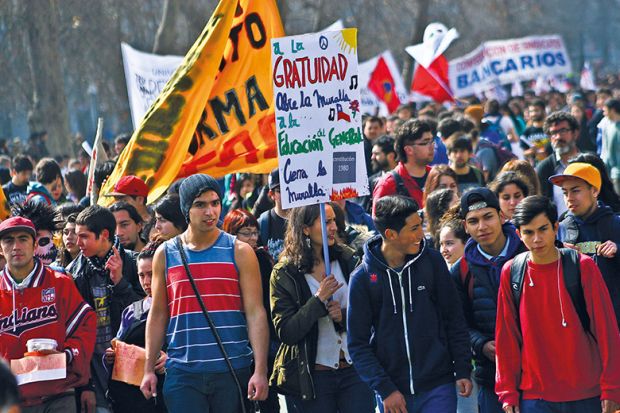With continued debate surrounding university tuition fees in the US and the UK, campaigners often turn to free higher education systems deployed in countries such as Germany for comparison.
But, as many point to the existence of fees as a barrier to access for lower-income pupils, policymakers should take heed of the recent experiences of Chile, according to the authors of a new report.
A policy set up by the Chilean government in 2016 to allow free tuition for lower-income students has not yet seen positive results, and researchers suggest the well-intentioned policy could even have a negative impact on social mobility in Chile.
Gratuidad was implemented on top of existing scholarships and tuition-fee loans as part of a bid to tackle low graduation rates and a growing class divide between pupils who do and do not go on to further study. The scheme initially applied to university and college students from families in the lower 50 per cent of income distribution, expanding to 60 per cent from 2018.
Analysis by Jason Delisle, resident fellow at the American Enterprise Institute, and Andrés Bernasconi, associate professor at the School of Education in the Pontifical Catholic University of Chile, suggests the initiative has left universities “underfunded”, and has “crowded out” students from the very poorest backgrounds for whom the scheme is intended.
“Instead of universal free college, gratuidad can best be described as having replaced a system of targeted financial aid and cost sharing [tuition fees] with a system that has slightly less targeted aid and moderately less cost sharing,” the authors note in Lessons from Chile’s Transition to Free College, published by the Brookings Institution.
Expanding scholarship benefits to middle-income families as well as the poorest pupils proves counter-intuitive, since universities can afford to be more selective in their admissions processes, they explain. Data collected from previous studies in the region show lower-income students tend to have lower test scores and are therefore “crowded out” from institutions they may once have been accepted into.
The full impact of the two-year-old gratuidad scheme is yet to be seen, but Mr Delisle and Professor Bernasconi say US policymakers should be “wary” of the potential consequences of a free system, which was debated by Democratic candidates in the 2016 presidential election. Enrolment rates for low-income students at US institutions “could decline if free college proposals lead to the type of crowding out predicted to occur in Chile’s system”, they say.
Another weakness highlighted is that not all universities are eligible or willing to participate in the gratuidad scheme; 30 of Chile’s 60 private universities – the majority of which are for-profit businesses or have too low accreditation – failed to join the programme in 2016.
Public universities, which are obliged to offer free tuition under the scheme, argue that government reimbursements are not sufficient to make up for the revenue lost from tuition fee charges.
At an average cost of $7,600 (£5,398) per year for public university courses – half the average annual family income – tuition fees in Chile are among the highest in the world. Only British and private US universities have higher prices relative to gross national product per capita.
“The country’s most prestigious universities, which have the highest cost structures, now face budget deficits because of gratuidad,” the report’s authors state. “They will likely have to cut spending to make up for declining revenue.”
Register to continue
Why register?
- Registration is free and only takes a moment
- Once registered, you can read 3 articles a month
- Sign up for our newsletter
Subscribe
Or subscribe for unlimited access to:
- Unlimited access to news, views, insights & reviews
- Digital editions
- Digital access to THE’s university and college rankings analysis
Already registered or a current subscriber? Login








